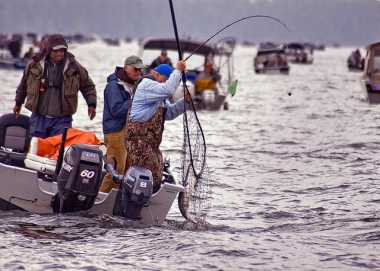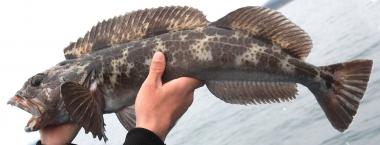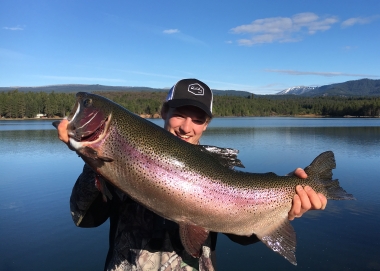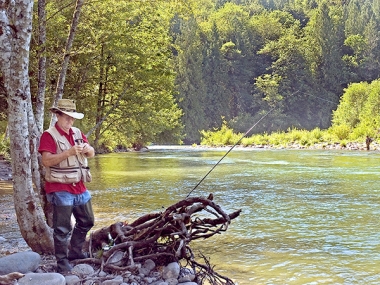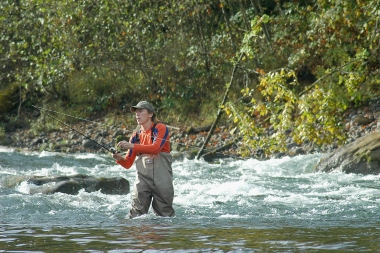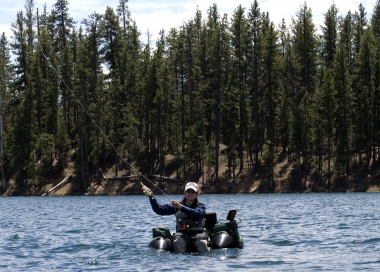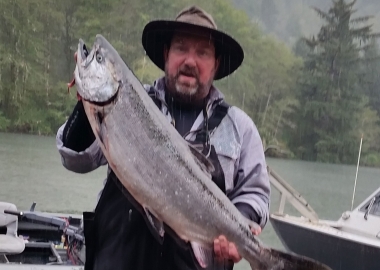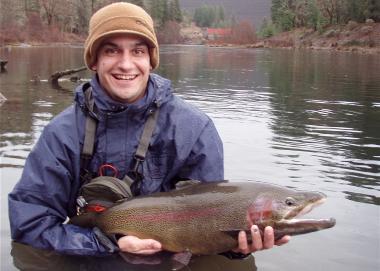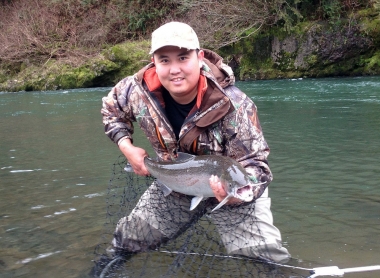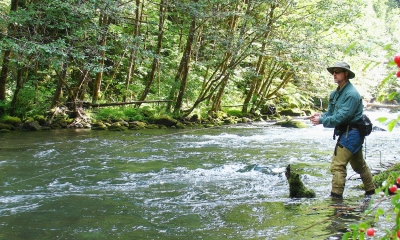
Seasonal Opportunities
Whatever the season, there’s bound to be good fishing somewhere in Oregon. Spring Chinook, summer bass, fall trout and winter steelhead – just some of the choices you’ll face.
SPRING
March, April, May
Spring marks the beginning of better conditions for both fish and anglers. Water temperatures – and sometimes the weather – begin to warm up and fish get on the move. Hungry trout are cruising, bass are preparing to spawn, and spring-run salmon are returning home.
Trout
Spring trout fishing can be some of the best fishing of the year. By March, trout stocking is well underway in lakes and reservoirs throughout the state. Fishing also can be excellent for holdover fish – trout stocked the previous year that have overwintered, and gotten big and hungry. In rivers and streams, insect hatches will be more prolific, also inspiring trout to be more active and likely to bite.
Tips for the season: The shallower waters in lakes and ponds will warm up first; so concentrate you efforts there early in the season and early in the day. Early in the season, snow fed rivers and streams can run high and cold; look for trout in slower waters near the bank or other quiet areas.
Warmwater
Some bass anglers wait all year for water temperatures to reach 50°F in the spring. That’s when smallmouth and largemouth bass move into shallower waters to prepare for spawning. These pre-spawn fish are aggressive and ready to attack a well-presented bass lure. It’s some of the best bass fishing of the year. Crappie fishing also is at its best during the cool spring weather.
Tip for the season: Keep an eye on water temperatures and be ready to hit the water when they reach 50-60°F; bass will be moving into shallower waters and in an aggressive pre-spawn mood.
Salmon
Spring Chinook is the first salmon run of the year. Fish begin arriving in fresh water in late winter and fishing usually peaks in mid- to late-spring. There are popular spring Chinook runs in the north and south coasts, Columbia River and Willamette River and its tributaries.
Tip for the season: Stay up-to-date with the most current regulations; salmon returns can be unpredictable and regulations may change from year to year, and may even be updated within the same season.
Steelhead
Anglers will begin to target early returning summer steelhead as early as April and May in the Sandy River and Willamette River and its tributaries like the Clackamas, McKenzie and Santiam.
Tip for the season: Watch the steelhead count at Willamette Falls; it will be an early indication that steelhead are beginning to move up the system into the tributaries.
Marine
Ocean fishing for halibut, salmon and bottomfish can be good whenever ocean conditions allow fishing boats to get out. For landlubbers, there’s jetty and surf fishing for bottomfish, lingcod, greenling and surfperch. Some of the best lingcod and surfperch fishing of the year can occur in late spring/early summer.
Tip for the season: Consider a charter; if you don’t have a boat to chase halibut or ocean salmon, there are charter fleets in many major ports. Watch the weather and tides; the best jetty and surf fishing is just after high tide as the tide is going out.
SUMMER
June, July, August
As summer heats up, trout stocking shifts to higher elevations where waters are cooler, warmwater anglers re-focus their attention on cooler, deeper waters, steelhead enthusiasts start wetting a line, and temperature refugees head to the coast to enjoy surf, jetty and ocean fishing.
Trout
Early summer fishing is a favorite time for trout fishing as water levels in rivers stabilize, water temperatures in lakes and reservoirs are still somewhat cool, and trout stocking continues in lakes, reservoirs and some streams. In lakes and reservoirs that freeze in the winter, some of the best fishing of the year will be right after ice-off.
With the onset of really hot weather, start looking for trout trying to beat the heat. This can be in higher elevation lakes where water temperatures stay cooler. There are several easily reached by the family car. For the more adventurous, ODFW also stocks dozens of hike-in only lakes.
Other good bets in the dog days of summer include the headwaters of streams and rivers where cooler waters often prevail thanks to lots of shade and higher elevations. Also check out the coastal rivers and streams where sea-run cutthroat trout begin arriving in July and August.
Tips for the season: In rivers and streams look for trout in the cooler waters found in shaded areas, deeper pools, and faster moving riffles with cooler, oxygenated water. In lakes and reservoirs, trout will hold in deep channels, near underwater springs, inlet streams and rivers, and off the face of dams (where it’s often deeper). Fish early and late in day when temperatures are cooler.
Warmwater
As the name suggests, fishing for warmwater species can continue to be good even after summer temperatures begin to heat up. As water temperatures continue to warm, however, bass will move out of the warmer shallows into deeper, cooler water. Many panfish, such as bluegill, may remain close to shore finding shelter among structure and weeds. Anglers also should consider the increasingly popular walleye fisheries in the Willamette River and Columbia River above Bonneville Dam.
Tips for the season: Look for smallmouth bass in rivers like the Umpqua and John Day; be sure to fish places in the shade, deeper pools and below riffles. In small ponds and lakes, shift from bottom fishing to fishing under a bobber; aquatic weeds begin to take off as waters warm and it can be easier to fish “above” them.
Salmon
Fall Chinook is the biggest salmon return of the year, and it begins in late summer. From the Columbia River and its tributaries to dozens of coastal rivers and streams, well over 1 million fish can return to fresh water to spawn. Summer is a period of transition from spring to fall Chinook. In early summer, anglers are still catching spring Chinook in the rivers and streams in northeast Oregon and the upper reaches of tributaries of the Willamette River. Beginning Aug. 1 anglers turn their attention to the fall fisheries, including the popular Buoy 10 fishery for Chinook and coho salmon.
Tips for the season: Stay up-to-date with the most current regulations; salmon returns can be unpredictable and regulations may change from year to year, and may even be updated within the same season. Bank anglers, this is your season; coastal rivers and streams offer excellent opportunities to fish from shore.
Steelhead
Summers steelhead is one of Oregon’s favorite fisheries. Several rivers east of the Cascades are renowned for their summer steelhead runs, including the Deschutes, John Day, Grande Ronde and Snake. The season will peak in the Willamette Basin in late spring/early summer. As steelhead continue their migration up the Columbia River, fisheries will pick up in tributaries like the Deschutes, where the summer season will last well into November.
Tips for the season: Plan for low, clear water conditions; smaller lures and flies in more subdued colors can be good choices. Be on the water early and late in the day; fish are on the move when the sun is off the water. Check the steelhead counts at dams; the number of fish passing Willamette Falls and Bonneville Dam provide a good look at how the season is progressing.
Marine
Ocean salmon fishing continues into summer, and a summer halibut season opens in August. Jetty and surf fishing are also good reasons to head to the beach. In the warmer months of summer and early fall, albacore tuna can move close enough to shore to tempt anglers.
Tip for the season: Check forecasted ocean conditions; large swells and high surf will make fishing more difficult.
FALL
September, October, November
Fall fishing can be some of the best of the year. Trout and warmwater fish are more active in cooler water temperatures and more interested in food, especially with winter approaching. Summer steelhead fishing peaks while access to marine fisheries can be limited by heavy fall storms.
Trout
Early fall fishing will feel a lot like late summer fishing, and trout will continue to pout in cool water refuges. But as the evenings get cooler and fall rains begin, the fishing will pick up. In fact, some of the best trout fishing of the year can be in September to November when trout get over their summer doldrums and start feeding heavily in anticipation of the upcoming winter.
Need more reasons to keep fishing after school starts? ODFW renews trout stocking in many popular water bodies in fall, the weather can be gorgeous and most of the crowds have gone home.
Tips for the season: As fall progresses, look for fish to move back into the shallows looking for warmer water. Sleep in. Trout will be more active as the waters warm later in the day.
Warmwater
There is a resurgence of warmwater fishing once water temperatures begin to cool in the fall. Crappie begin schooling in the shallows, and bass will be feeding heavily in anticipation of the winter.
Tip for the season: In fall, crappie congregate in loose schools around sunken logs or brushy cover or just beyond the weeds in water 6- to 15-feet deep.
Salmon
On the coast, fall salmon fishing begins to pick up in the bays and estuaries in late August or early September. These fisheries will begin to move upriver once fall rains have raised river levels enough to draw fish in. Anglers also look forward to coho fisheries in the Sandy and upper Willamette rivers.
Tip for the season: Be patient while coho fishing in rivers; coho can be lure shy and it might take a while to dial in this fishery.
Steelhead
While summer steelhead fishing continues, especially on rivers a little further from the ocean, late fall begins a transition to winter steelhead.
Tips for the season: Be stealthy and discreet; low, clear water conditions call for quieter presentations of small, subdued-colored flies and lures. Fish early and late in the day; steelhead go on the move when the sun is off the water.
Marine
Many of the summer fisheries continue into fall. As the season progresses, however, late fall storms can make ocean conditions difficult if not dangerous.
Tip for the season: Watch for heavy surf; it can make shore and jetty fishing potentially dangerous.
WINTER
December, January, February
There's no reason to stow away the fishing gear just because winter has arrived. Trout fishing is open in most lakes and several major rivers, and actually can be quite good in the winter months. In many places, winter steelhead fishing really begins to heat up after the first of the year and fishing for ocean rockfish can be very good, when ocean conditions allow.
Trout
For lakes and reservoirs that are open year-round, trout fishing can continue until the water freezes, or snow and ice limit access. Lakes that were stocked earlier in the year will have holdover trout that have been in the water several months getting bigger. Ice fishing, when possible, is becoming increasingly popular at Diamond Lake and many reservoirs in eastern Oregon. However, ice conditions in Oregon can be unpredictable and anglers should use caution.
There also are several rivers in Oregon that are open year-round and offer excellent trout fishing for the hardy angler. Trout continue to feed throughout the winter but are generally less active than other times of the year. Water levels can be high in the winter, making wading difficult. However, the high waters also push the fish closer to shore in search of slower currents or back eddies where they don’t have to expend a lot of energy to hang out in the current.
Tips for the season: Sleep in, and enjoy breakfast; fish are most active during the warmest part day (late morning/early afternoon). Cover water carefully and thoroughly with your lure or fly; trout feed selectively in winter and won’t move far to feed.
Warmwater
Yellow perch offers some of the best warmwater fishing of the winter season. Yellow perch continue to feed actively throughout the winter. Since they’re often near the bottom of the water column, they’re most accessible from a boat or through the ice. Other species, such as largemouth and smallmouth bass, are much harder to catch in the winter, especially after water temperatures fall to less than 50°F.
Tips for the season: Consider ice fishing for yellow perch; they’re active winter feeders and excellent table fare.
Steelhead
Maybe it’s the blustery winter weather, or maybe it’s the hard-fighting fish, but winter steelhead fishing has a special mystique among many Oregon anglers. Winter steelhead fishing on some rivers begins as early as Thanksgiving, but most fisheries really get going after the first of the year. Fisheries on the coast and in the Willamette Valley offer plenty of opportunity for both boat and bank anglers.
Tips for the season: Keep an eye on water levels; some of the best steelhead fishing is after a high water event as water levels begin to drop. Search the softer water; fish will often hold in slower pockets of water away from the main current.
Marine
When ocean conditions permit, bottomfishing can be good throughout the winter months.
Additional Resources
Check salmon/steelhead harvest statistics
ODFW collects salmon and steelhead harvest statistics from rivers and streams throughout the state. This data can help you pinpoint productive fisheries.
Fish Counts at Major Dams and Fish Traps
The number of fish passing over dams can be a good indicator of how many fish are in the river and how the run is progressing.
Animated Knots by Grog
One of our favorite web resources for tying the most common fishing knots.

